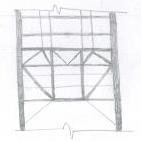Search the Community
Showing results for tags 'crack control'.
-
Assalam o Alykum. What will be the allowable crack width value for water retaining structures ? As per ACI code. Incase outer face of water tank retaining wall is covered with soil and inner face with small amount of water for example 200mm. Shall we use the allowable crack width value for water retaining structures ? I read it's 0.1mm for water retaining and 0.3mm for soil.
-
Hi guys just to discuss with you my understanding of crack widths in Environmental structures according to ACI. --------------------------- Normal structures --------------------------- 1. ACI 318-95 based on statistical method of Gergely & Lutz 1968 limits Z based on exposure. We are calculating crack widths here. (Normal structures) 2. ACI 318-99 proposed limiting the spacing and removed actually calculating the width and also removed the exposure conditions. For example for beams and one-way slabs s (in) = 540/fs -2.5cc or in other words limiting the fs=0.6fy (For normal structures) 3. ACI 224R-01 references method 1 and 2 above and 3 european codes. The most confusing part is the table in which Nawy suggests 0.1mm crack width for water-tight structures. The whole document is for normal structures except this line. And people are following this line and refer to this document for water tight structures. I mean its just a suggestion and by the way this method 1 is obsolete now since ACI 318-99 (see point 2 above). --------------------------- Water tight structures --------------------------- 1. ACI 318-08 states clearly that for watertight structures ACI 350-06 codes should be used. 2. ACI 224.4R-13 also specifically states that for watertight structures walls in section 7.4, we should use ACI 350-06. 3. ACI 350-06 for water tight structures does not recommend calculating a number for crack width but rather limiting max steel stress in bars to be 20k ksi or fs=0.33fy for normal conditions. --------------------------------------------------------------------------------------------------------- To sum it up, Philosophy of crack width control is not to calculate probable crack widths but to limit the max stress in steel bars. For normal structures: fs=0.6fy and for water tight structures fs=0.33fy
-
I want to comment on some modelling issues in ETABS. Though some of these things are discussed elsewhere in the forum, I hope to extract some more useful conclusions. First thing is related to modelling the bending stiffness of flexural members, for strength level loads, that is representative of their condition near failure. The ACI code specifies the modifier of 0.35 on gross moment of inertia to represent its condition at yielding. Some people say that the factor should be multiplied by 2 to represent the stiffness of T-beam. This approach would be justified if you are not taking into the account the out of plan bending stiffness of slab. But, ETABS does include the out of plane bending stiffness if you have modelled the slab by using shell elements. So, a factor of 0.7 would overestimate the stiffness of your structure in this case, and will lead to under-design. If one has used the modifier of 0.35 in ETABS for beams in beam-slab floor system, then what value should be adopted for slab? It should not be 0.25, as this value has been specified for flat plates and flat sab floor system. If one is using some value of modifier for out of plane bending stiffness on shells, then the share of the bending moment in beams will be reduced accordingly. This approach is correct if one will be providing the reinforcement in column strips of slab. But, if you are providing reinforcement in slab in the direction perpendicular to supports only, i.e. beams, as is the general practice in Pakistan, then you are under-estimating the flexural demand in beams. Now, there is also a question of factors to be used while deciding the amount of reinforcement required in beams, columns and shear walls. If you are using factors 0.35 for beams and shear walls, and 0.7 for columns, then you are finding out the demand in members at the point of yielding, and this conforms to the code. But, this also means that the structure might experience unacceptable cracks widths. So, if you are using 0.35 for calculating the demand at strength-level forces, then you should also perform crack-control-check at service-level loads by using the factor of 1. If you are calculating the strength-level demand with a modifier of 1 for all structural members, after you have decided the location and the number of shear walls with modifier of 0.35, then you are overestimating seismic forces, as you are underestimating the time-period. But, the structural performance will improve.
- 5 replies
-
- stiffness modifiers
- baz tips
-
(and 1 more)
Tagged with:

